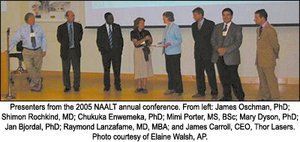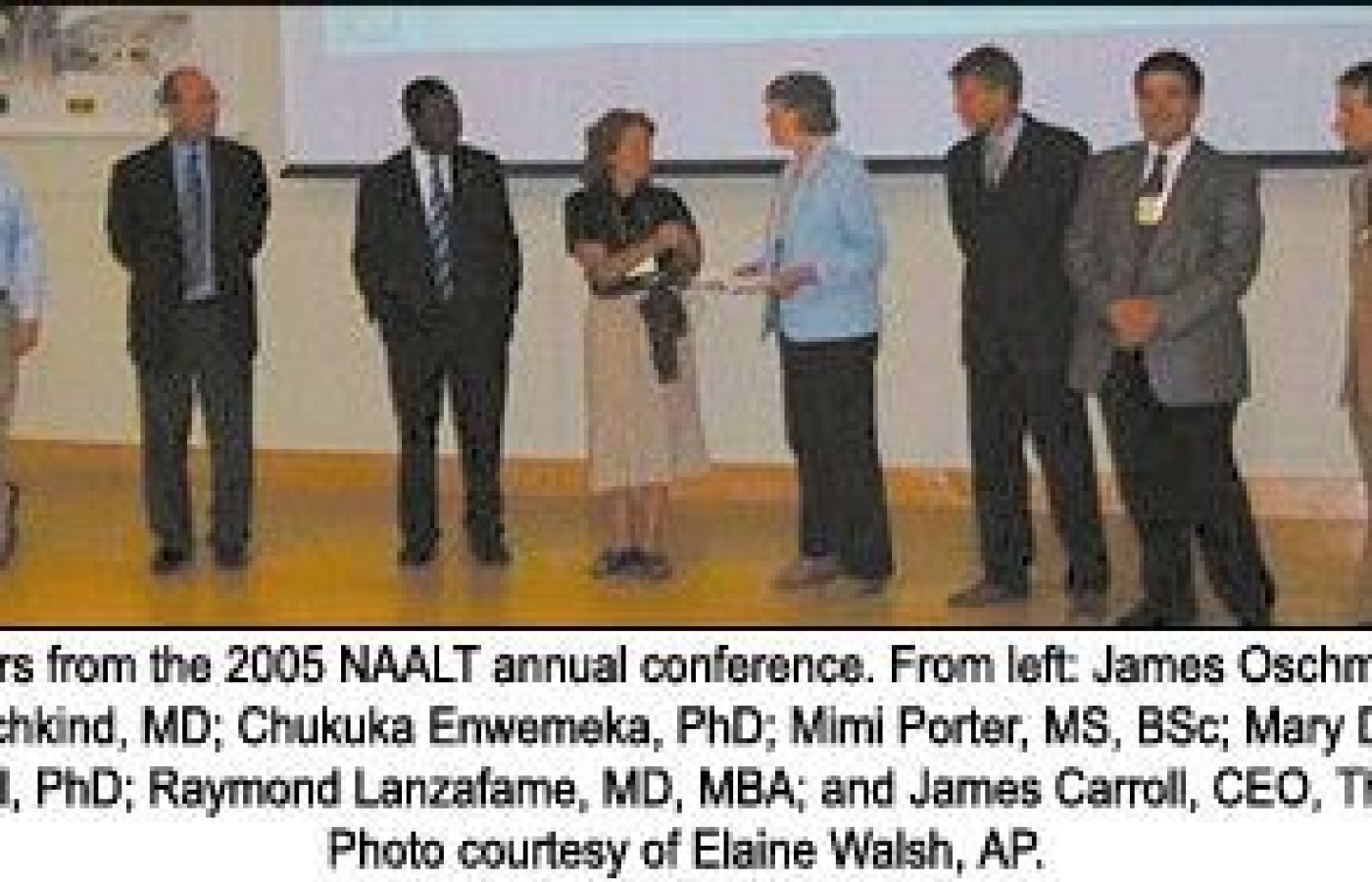Whether you accept it, avoid it or live somewhere in between, insurance coverage has become a defining issue for our profession. Patients increasingly expect to use their benefits, practitioners want to be compensated fairly for their time and expertise, and the system itself remains – at best – fragmented. The encouraging news is that coverage has expanded in meaningful ways. The challenging news is that reimbursement, across the board, remains inadequate.
Laser Therapy in North America: NAALT 2005
"How far does light travel in tissue?"
"From your nose to your toes."
This was the reply of James Oschman, PhD, to a question from a member of the audience at this year's annual conference of the North American Association for Laser Therapy (NAALT), held May 20-22 in Ft. Lauderdale, Florida. Dr. Oschman has devoted his career to studying and documenting the science of energetic medicine, and was the keynote speaker at the conference. He is also a former president of the New England School of Acupuncture, and has a keen appreciation of Oriental medicine.
The body is a single, continuous system in which the acupuncture meridians are the primary photonic and electromagnetic pathways. Although it has been a basic tenet of Oriental medicine for thousands of years that a tiny stimulus may propagate throughout a living system, what is new is that we are now able to distinguish many of the biological structures and mechanisms that amplify and transmit these signals.
Connective tissues, cell membranes, sensory receptors and many other biological structures are composed of highly ordered arrays of molecules. Once energy reaches a certain threshold within these structures, their molecules may begin to vibrate in unison. Resonance may produce a physical vibration or may cause the emission of energy across a broad range of the electromagnetic spectrum from coherent light (biophotons) through radio waves.
After moxibustion or other light stimulation, Schlebush et al. used a thermographic camera to record the appearance on the body of images of the Stomach and Spleen channels.1 When burning moxa was held near the subject's left leg, the shapes of the left Stomach meridian and right Spleen meridian were revealed. When applied on the other side, a mirror image was the result. These results were reproducible, and the images that accurately depicted the course of the meridians were among the highlights of Dr. Oschman's presentations.
"Light is likely to be absorbed and changed before it goes too far," said Mary Dyson, PhD, responding to the very same question asked of Dr. Oschman as to the distance light travels in tissue. Dr. Dyson has studied the effects of laser and other light therapy on cells and tissue in a noteworthy body of research extending back to the 1970s. She is also a dynamic speaker, whose modesty and sense of humor invariably captivate an audience.

"While we may understand most of the effects of light on isolated cells, we simply cannot evaluate systemic effects as long as we limit ourselves to the laboratory," Dr. Dyson said. She summarized the effects of light in vitro while emphasizing that cells do not exist in isolation under normal conditions, but are in constant contact and communication with one another and function together. To understand and appreciate the deeper effects of laser therapy, we will need to study its influence in living animals and humans in detail.
Shimon Rochkind is a world renowned Israeli neurosurgeon who has pioneered techniques for nerve regeneration and transplantation. In this writer's estimation, Dr. Rochkind is laser therapy's most likely candidate for a Nobel Prize. He has used laser therapy since the 1970s, successfully treating many cases of nerve injury and paralysis.
Dr. Rochkind presented the results of a double-blind, randomized, placebo-controlled study of patients with peripheral and brachial plexus injuries that had occurred from six months to several years prior to treatment. His conclusions were that even in a patient population such as this, in which injury has been present for some time, laser therapy improved neural functioning progressively and led to greater functional recovery.
Dr. Rochkind reported that laser therapy has an immediate protective effect on injured nerves and increases their functional activity. In his experience over time, it helps to maintain neurological activity, prevent scar formation and inhibit degeneration in motor neurons following injury while significantly promoting axonal growth and myelinization.
Other highlights of the conference included the following:
Margaret Naeser, PhD, LAc, gave a comprehensive presentation of her research with laser acupuncture for the treatment of paralysis in stroke, carpal tunnel syndrome and other applications.
Jan Bjordal, PhD, analyzed existing reviews of laser therapy studies in the treatment of chronic tendon and joint disorders and reported a number of errors and inconsistencies in methodology on the part of the reviewers. Dr. Bjordal is working to establish new guidelines for systematic reviews of low-level laser therapy, and presented preliminary ideas as to how studies and their reviews might be improved.
Incoming NAALT President Raymond J. Lanzafame, MD, MBA, emphasized proper wavelengths and dosages in wound healing.
Chukuka Enwemeka, PhD, spoke about the underlying mechanisms of phototherapy in wound healing and in muscle and connective tissue repair. Dr. Enwemeka also reported on the outcomes of a study comparing the effects on connective tissue repair when different wavelengths were used singly, in combination, and along with other modalities, including ultrasound, electrotherapy and early mobilization. He opened the workshop portion of the conference with a discussion of methods to treat carpal tunnel syndrome. Dr. Enwemeka is president emeritus of NAALT and dean of the New York Institute of Technology's School of Allied Health and Life Sciences.
Paul Bradley, MD, presented mechanisms of pain relief and clinical approaches to address a variety of head and neck conditions. He offered strategies to address myofascial and neuropathic pain, including specific recommendations for dosage, pulse rate and various clinical approaches. Dr. Bradley is the outgoing president of NAALT and director of the Head and Neck Pain Clinic at Nova Southeastern University, the institution that hosted this year's conference.
Karen Carroll, DO, ND, addressed contraindications, precautions and special considerations in laser therapy. She emphasized that there are many "gray areas," and that dosage/treatment time and methods must be adjusted according to the type of tissue to be treated, age of the injury, depth of injury, and sensitivity of the patient.
Martin Gold, MBA, addressed reimbursement issues with laser therapy, and Curtis Turchin, DC, gave an excellent presentation on techniques to build one's practice.
The preceding is this writer's view of some of the conference highlights, which may be neither complete nor entirely accurate. This year's symposium was the largest in the association's history. More than 15 percent of those attending were acupuncture physicians. For more information on NAALT, visit www.naalt.org.
Reference
- Schlebush KP, Walburg MO, Popp FA. Biophotonics in the infrared spectral range reveal acupuncture meridian structure of the body. The Journal of Alternative and Complementary Medicine 2005;11(1):171-173.



